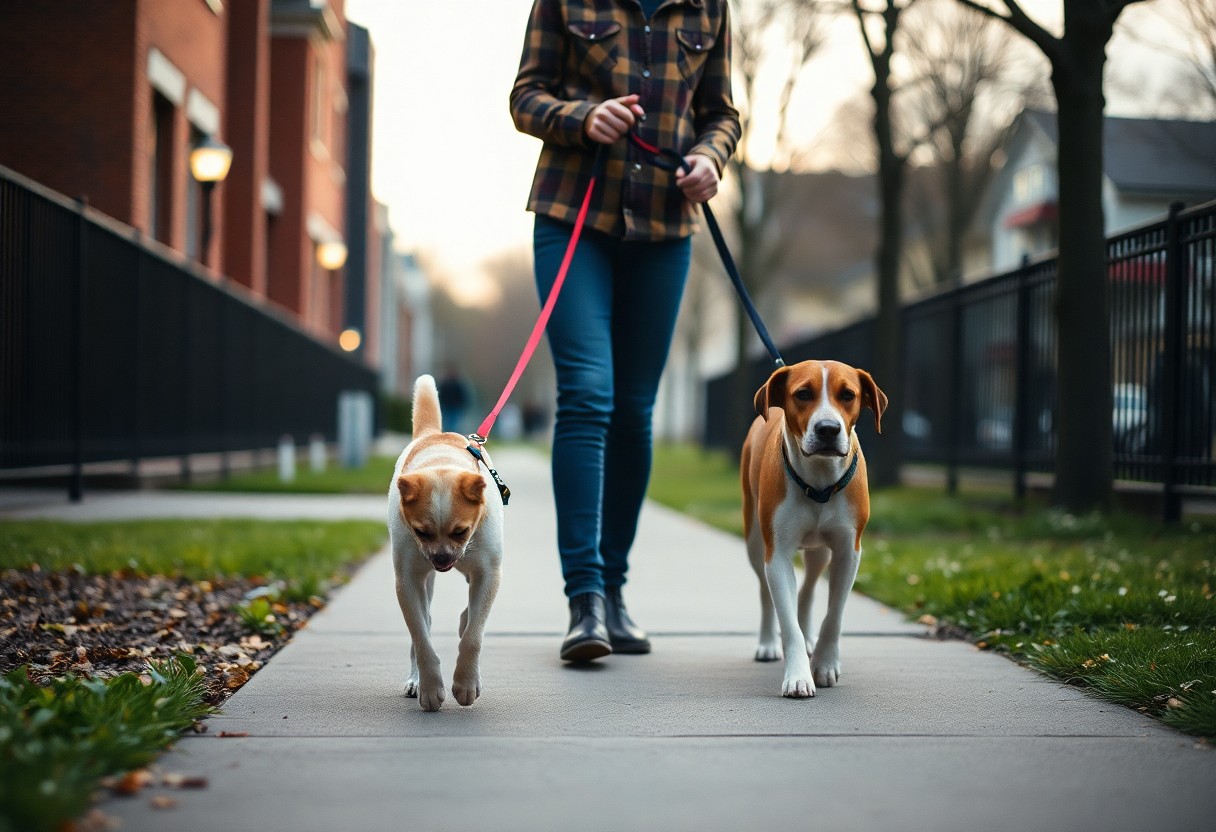Just like teaching any skill, getting your dog to walk on a leash without pulling can take patience and practice. By using positive reinforcement techniques, you can create a calm and enjoyable walking experience for both of you. It’s important to note that pulling can lead to injuries for both you and your dog, as well as create negative associations with leash time. In this guide, you will learn effective methods to encourage your dog to walk politely by your side, making every walk a pleasure.

Understanding Why Dogs Pull
For many dog owners, the act of their pet pulling on the leash can be frustrating. Understanding the reasons behind this behavior is crucial in teaching your dog how to walk calmly beside you. Dogs often pull due to their natural instincts, excitement, or simply because they have not been taught the proper walking behavior. Recognizing these factors will help you effectively address the issue and improve your walks together.
Natural Instincts
With a dog’s ancestry rooted in hunting and herding, pulling on the leash can stem from their natural instincts. In the wild, dogs use their strength and speed to chase prey and explore their environment. When on a leash, your dog may instinctively want to pull ahead to satisfy their curiosity and energy, making it crucial for you to redirect this behavior positively.
Lack of Training
Among the most common reasons for a dog pulling on its leash is a lack of training. Many owners underestimate the need for proper leash manners, which can lead to a dog who has learned that pulling is acceptable behavior. Without consistent training, your dog cannot understand what is expected during walks, which can make the experience chaotic and challenging for both of you.
Lack of training can result in unwanted behaviors that not only make walks unpleasant but can also lead to potential hazards for both you and your dog. If your dog is pulling, it may put themselves and others at risk of injury when crossing roads or encountering other pets. It is crucial to invest time in teaching your dog proper leash manners, as this will enhance your bond and ensure safe walks for everyone involved. With consistent training and a focus on positive reinforcement, you can significantly improve your dog’s walking behavior.
1. Start with short leash walks for practice.
2. Use treats to reward your dog for walking calmly.
3. Choose the right collar or harness for control.
4. Stop walking when your dog pulls to reinforce behavior.
5. Change direction frequently to keep your dog engaged.
6. Be patient and consistent during training sessions.
Choosing the Right Equipment
Some of the most important factors in teaching your dog to walk on a leash without pulling hinge on the equipment you select. The right leash, collar, or harness can make a significant difference in your dog’s comfort and effectiveness in training. You should focus on choosing products that provide safety, control, and comfort, ensuring enjoyable walks for both you and your furry friend.
Leash Options
Among the various leash options available, you will find standard leashes, retractable leashes, and training leashes. Standard leashes are typically 4 to 6 feet long and provide great control. Retractable leashes allow your dog more freedom but can encourage pulling if not managed properly. Training leashes provide additional length for teaching commands, but you should use them with care to maintain control over your dog’s movement.
Harness Versus Collar
Below are two common choices for walking your dog: a harness and a collar. A harness distributes pressure across your dog’s body, reducing stress on their neck and making it less likely for them to escape. A collar, on the other hand, is easier to put on and can offer quick identification. However, if your dog tends to pull, a collar can put unnecessary strain on their neck, leading to injury. Understanding the benefits and drawbacks of each will help you make the best choice for your dog’s walking experience.
Due to the differences in design, harnesses are generally recommended for dogs prone to pulling or those with respiratory issues, as they minimize pressure on the neck. In contrast, collars can be more convenient for quick outings or identification purposes. Whichever you choose, ensure that it fits well; a poorly fitting harness can cause discomfort or escape, while a loose collar may not effectively control your dog. Ultimately, selecting the right equipment will set a solid foundation for successful leash training.
Teaching Loose Leash Walking
Keep your training approach consistent and patient, as teaching your dog to walk on a loose leash takes time and repetition. Begin in a quiet area without distractions and focus on rewarding calm behavior as your dog adjusts to the leash. By practicing regularly, your pup will learn to associate walking beside you without pulling as a positive experience.
Start with Basic Commands
Leash training is more effective when you start with basic commands such as “sit,” “stay,” and “heel.” These commands create a foundation for good behavior and help communicate your expectations to your dog. Practice these commands in a quiet environment before introducing the leash, so your dog understands their meaning.
Reward-Based Training Techniques
After establishing the basics, incorporate reward-based training techniques to reinforce good leash manners. Use treats, praise, and affection to reward your dog when they maintain a loose leash. This positive association encourages them to stay by your side rather than pulling away. The key is to be consistent and patient as your dog learns.
Considering that positive reinforcement builds trust between you and your dog, this method can significantly improve their behavior. Whenever your dog walks beside you without pulling, offer a high-value treat or enthusiastic praise to reinforce the desired behavior. Avoid harsh corrections, as they can create anxiety and lead to fear-based reactions. Instead, focus on being calm and encouraging, allowing your dog to learn through positive experiences. Over time, your dog will naturally gravitate toward walking in a manner that keeps the leash loose, making walks enjoyable for both of you.
Practicing Consistency
Your dog thrives on routine, making consistency vital during leash training. Establish a clear set of rules and signals that you will consistently apply every time you go for a walk. This helps your dog understand what is expected, reducing confusion and fostering good habits. Practice patience and remain committed to reinforcing positive behaviors, ensuring a successful learning experience for both you and your furry friend.
Setting Aside Training Time
Above all, dedicate specific time for training each day, even if it’s just a few minutes. Consistency is key, and frequent short sessions can be more effective than infrequent longer ones. Find a time that works for you and your dog, treating it as a valuable bonding experience that builds trust and mutual understanding.
Encouraging Good Behavior
Above all, focus on rewarding your dog for walking beside you without pulling. Use treats, praises, or toys to reinforce this positive behavior whenever your dog stays close to you during walks. This way, your dog associates good behavior with enjoyable rewards, promoting a structured walking experience.
It’s vital to recognize rewardable moments during walks, such as when your dog sits calmly or looks at you instead of pulling ahead. Utilize positive reinforcement by offering treats or verbal praises. By consistently reinforcing good behavior, you establish a clear connection between staying near you and receiving rewards, which strengthens their learning experience and builds a stronger bond.
Dealing with Distractions
All dogs encounter distractions during walks, from people to other animals and sounds. Successfully teaching your dog to ignore these stimuli is key to achieving a pleasant leash experience. Start with controlled environments and gradually introduce more challenging situations as your dog becomes more confident. This process helps your dog learn to stay focused on you, minimizing the chances of pulling.
Gradual Exposure to Various Stimuli
Below, introduce your dog to various stimuli in a controlled manner. Start in a quiet area, then slowly expose your dog to bustling sidewalks, other dogs, and unfamiliar noises. Ensure each session is brief and positive, allowing your dog to adapt gradually. This gradual exposure reduces anxiety and teaches your dog to remain calm despite distractions.
Techniques to Maintain Focus
By employing specific techniques, you can enhance your dog’s focus on you during walks. Use treats, toys, or engaging commands to redirect your dog’s attention from distractions. Practicing these techniques regularly will teach your dog to associate distractions with your cues rather than reacting impulsively.
Understanding your dog’s focus and attention span can significantly enhance leash training. Use high-value treats or favorite toys to reward your dog for maintaining focus on you rather than being sidetracked by distractions. Incorporate consistent commands such as “look” or “leave it” to guide your dog’s attention back to you. Gradually increase the level of distractions while ensuring your dog remains calm and responsive. This approach not only teaches your dog to be more attentive but also fosters a stronger bond between you and your furry friend.
Troubleshooting Common Issues
After you start teaching your dog to walk on a leash, you may encounter some common issues that can arise. It’s important to stay patient and consistent while troubleshooting these problems. Pay attention to your dog’s behavior and be willing to adjust your training methods as needed to ensure a successful and enjoyable walking experience.
Addressing Over-Excitement
Troubleshooting over-excitement can be a challenge, especially if your dog becomes overly enthusiastic while on a leash. Use a calm voice and slow movements to redirect your dog’s attention and encourage them to focus on you, rather than the distractions around them. Provide frequent breaks and reward your dog for maintaining a relaxed demeanor.
Handling Setbacks in Training
Around every corner of dog training, you might face setbacks that can feel discouraging. Stay positive and adapt your training plan to cater to your dog’s specific needs. If an unexpected reaction occurs, calmly address it without frustration. Often, it helps to shorten training sessions or revisit foundational exercises to reinforce good behavior.
Handling setbacks in training can be particularly frustrating, but maintaining a positive attitude is key. If your dog pulls or becomes distracted, take a step back and assess the situation. Simplify the environment by minimizing distractions and start with short, manageable training sessions. Celebrate any small victories; they’re important milestones in your dog’s progress. Your persistence and encouragement will foster a strong bond and ultimately lead to a more successful leash-walking experience.
Final Words
Drawing together the techniques discussed, you can successfully teach your dog to walk on a leash without pulling by implementing consistent training methods, positive reinforcement, and patience. Focus on gradually introducing your dog to the leash and practicing loose-leash walking in various environments. It is necessary to remain calm and encourage good behavior. For additional guidance, you can explore this comprehensive resource to Teach Your Dog to Walk on Leash Without Pulling. Happy training!
 wagwagtail "only love can make your dog wag her tail"
wagwagtail "only love can make your dog wag her tail"
